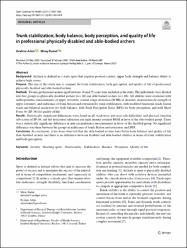| dc.contributor.author | Arkın, İbrahim | |
| dc.contributor.author | Budak, Miray | |
| dc.date.accessioned | 2021-12-10T05:56:53Z | |
| dc.date.available | 2021-12-10T05:56:53Z | |
| dc.date.issued | 2021 | en_US |
| dc.identifier.citation | Arkın, İ. ve Budak, M. (2021). Trunk stabilization, body balance, body perception, and quality of life in professional physically disabled and able-bodied archers. Sport Sciences for Health, 17(4), 881-889. https://dx.doi.org/10.1007/s11332-021-00744-9 | en_US |
| dc.identifier.issn | 1824-7490 | |
| dc.identifier.issn | 1825-1234 | |
| dc.identifier.uri | https://dx.doi.org/10.1007/s11332-021-00744-9 | |
| dc.identifier.uri | https://hdl.handle.net/20.500.12511/8629 | |
| dc.description.abstract | Background Archery is defined as a static sport that requires postural control, upper body strength and balance ability to achieve high scores. Purpose The aim of this study was to compare the trunk stabilization, body perception, and quality of life of professional physically disabled and able-bodied archers. Methods Twenty professional archers aged between 18 and 55 years were included in the study. The individuals were divided into two groups as physically disabled archers (n = 10) and able-bodied archers (n = 10). All athletes were evaluated with anthropometric measurements of upper extremity, normal range of motion (ROM) of shoulder, manual muscle strength of upper extremity, and endurance of trunk flexion and extension for trunk stabilization, with modified functional reach, lateral reach and bilateral reach tests for body balance, with Body Perception Scale (BPS) for body perception, and with Short Form 36 (SF-36) for quality of life. Results Statistically significant differences were found in all reach tests, physical role difficulties and physical function sub-scores of SF-36, and left horizontal adduction and right internal rotation ROM in favor of the able-bodied group. There was a statistically significant difference in arm circumference measurements in favor of the disabled group. No significant difference was there between the groups in endurance of trunk flexion and extension, and BPS. Conclusion In conclusion, it has been observed that the able-bodied archers have better body balance and quality of life than disabled archers and there is no difference between disabled and able-bodied athletes in terms of trunk stabilization and body perception. | en_US |
| dc.language.iso | eng | en_US |
| dc.publisher | Springer Nature | en_US |
| dc.rights | info:eu-repo/semantics/embargoedAccess | en_US |
| dc.subject | Archery | en_US |
| dc.subject | Shooting Sports | en_US |
| dc.subject | Functionality | en_US |
| dc.subject | Stabilization | en_US |
| dc.subject | Balance | en_US |
| dc.subject | Perception | en_US |
| dc.subject | Quality of Life | en_US |
| dc.title | Trunk stabilization, body balance, body perception, and quality of life in professional physically disabled and able-bodied archers | en_US |
| dc.type | article | en_US |
| dc.relation.ispartof | Sport Sciences for Health | en_US |
| dc.department | İstanbul Medipol Üniversitesi, Sağlık Bilimleri Enstitüsü, Fizyoterapi ve Rehabilitasyon Ana Bilim Dalı | en_US |
| dc.department | İstanbul Medipol Üniversitesi, Sağlık Bilimleri Fakültesi, Ergoterapi Bölümü | en_US |
| dc.authorid | 0000-0003-1304-2309 | en_US |
| dc.authorid | 0000-0003-0552-8464 | en_US |
| dc.identifier.volume | 17 | en_US |
| dc.identifier.issue | 4 | en_US |
| dc.identifier.startpage | 881 | en_US |
| dc.identifier.endpage | 889 | en_US |
| dc.relation.publicationcategory | Makale - Uluslararası Hakemli Dergi - Kurum Öğretim Elemanı | en_US |
| dc.identifier.doi | 10.1007/s11332-021-00744-9 | en_US |
| dc.identifier.scopusquality | Q3 | en_US |


















